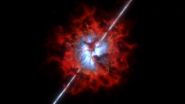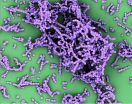(Press-News.org) (June 11, 2014 Seattle, Wash.)
Researchers at Benaroya Research Institute at Virginia Mason (BRI) used cutting-edge tetramer technology developed at BRI to find the T cells that drive rheumatoid arthritis (RA). "By using tetramer technology, we were able to examine whether T cells in people with rheumatoid arthritis were increased in number or were unique in other ways," says BRI Associate Director Jane Buckner, MD, who led the study with BRI Tetramer Core Laboratory Manager Eddie James, PhD. The findings were recently reported online in Arthritis & Rheumatology.
This tool now allows scientists to study how RA starts, how current therapies may impact the immune response directed to the joint and how to specifically target these cells therapeutically. "For the first time, we were able to demonstrate that T cells that recognize proteins in the joint were increased in the blood of people with RA and that these cells had a unique set of markers. Further we were able to demonstrate that the number of these cells changes over time in patients and with treatment." BRI is an international leader in developing tetramer technology which allows scientists to isolate cells that are difficult to pinpoint, often compared to finding a needle in a haystack.
"RA is a debilitating disease affecting people of all ages including children," says Dr. Buckner. "Many people are diagnosed in their early 20's, 30's and 40's, and it impacts them at a very productive time of their lives. We used to see people with RA in wheelchairs and needing joint replacements, but during the last 15 years we have seen incredible progress in new therapies. If people are appropriately diagnosed and treated, they can work full time and be healthy, active adults. But they can still suffer and need medications that have risks and side effects. The drugs can be costly and sometimes they don't work or eventually stop working. If untreated, the disease will permanently destroy joints and cause pain. We would like to find ways to treat people early and target only the cells that cause the disease and eventually, prevent this disease."
Rheumatoid arthritis is thought to be a T cell mediated disease and is caused when the body's immune system mistakenly begins to attack its own tissues, primarily the synovium, the membrane that lines the joints. As a result of this autoimmune response, fluid builds up in the joints, causing joint pain and systemic inflammation.
RA is a chronic disease in which most people experience intermittent periods of intense disease activity punctuated by periods of reduced symptoms or even remission. In the long term, RA can cause damage to cartilage, tendons, ligaments and bones which can lead to substantial loss of mobility.
An estimated 1.3 million people in the United States have RA—almost 1 percent of the nation's adult population. There are nearly three times as many women as men with the disease. In women, RA most commonly begins between the ages of 30 and 60. In addition, as many as 300,000 children are diagnosed with a distinct but related form of inflammatory arthritis called juvenile arthritis.
This work was funded by an Autoimmune Disease Prevention grant from the National Institutes of Health. A new grant of $1.3 million from the U.S. Department of Defense will extend the discovery to ask in-depth questions about whether these T cells reflect disease activity and if they change in patients who respond to therapy. Drs. Buckner and James will lead the study with Bernard Ng, MD, Chief of Rheumatology, Veterans Affairs Puget Sound Healthcare System. Research will include biorepository studies of samples voluntarily provided by Veterans Affairs and BRI research participants who help to advance science.
INFORMATION:
About Benaroya Research Institute at Virginia Mason
Benaroya Research Institute at Virginia Mason (BRI), founded in 1956, is an international leader in immune system and autoimmune disease research, translating discoveries to real-life applications. BRI employs more than 275 scientists, physician researchers and staff, supported in part by grants from the National Institutes of Health (NIH), the U.S. Department of Defense, JDRF, the Leona M. and Harry B. Helmsley Charitable Trust and others. BRI heads up several national and international consortiums and leads the Immune Tolerance Network (ITN), a research cooperative network funded by the National Institute of Allergy and Infectious Diseases (NIAID), part of the NIH.
Visit BenaroyaResearch.org or Facebook.com/BenaroyaResearch for more information about BRI, clinical studies and different types of autoimmune diseases.
Benaroya Research Institute scientists identify drivers of rheumatoid arthritis
Researchers receive $1.3 million to expand studies
2014-06-11
ELSE PRESS RELEASES FROM THIS DATE:
New strategies to combat MRSA in hospitals
2014-06-11
CHICAGO (June 11, 2014) – New guidelines aim to reduce the prevalence of methicillin-resistant Staphylococcus aureus (MRSA), improve patient safety and prioritize current prevention efforts underway in hospitals. This drug resistant bacterium is a common source of patient morbidity and mortality in U.S. hospitals, causing nearly twice the number of deaths, significantly longer hospital stays and higher hospital costs than other forms of the bacteria.
The strategies were published in the July issue of Infection Control and Hospital Epidemiology and produced in a collaborative ...
Targeted mass killings can be prevented
2014-06-11
New Rochelle, NY, June 11, 2014–Disagreeing with comments made by Richard Friedman in a recent New York Times op-ed piece, Mary Ellen O'Toole, PhD, Senior FBI Profiler/Criminal Investigative Analyst (ret.), states that there is "a critical and significant difference" between being able to predict and prevent mass shootings. Dr. O'Toole, who is Editor-in-Chief of Violence and Gender, calls on the media to stop using the names of mass murders, which only fuels their desire for fame and is "a very powerful motivator," in a Perspective in the new peer-reviewed journal from ...
Guidelines needed for creating germ cells in vitro, Cornell, JAX scientists state
2014-06-11
Research aimed at developing germ cells—the progenitors of eggs and sperm—in vitro should be held to especially rigorous scientific standards, a distinguished team of reproductive biologists declares in the journal Cell.
In the article, authors John Schimenti, Ph.D., of Cornell University and his Jackson Laboratory colleagues, Mary Ann Handel, Ph.D., and John Eppig, Ph.D., note that because "germ cells are the ultimate stem cells," laboratories are racing to develop these cells in vitro for assisted reproduction.
Yet the researchers claim that no one has yet conclusively ...
Mining data archives yields haul of 'red nuggets'
2014-06-11
The world of astronomy has changed. An astronomer used to have to travel to a remote location and endure long, cold nights, patiently guiding a telescope to collect precious photons of light. Now, a proliferation of online archives allows astronomers to make discoveries from the comfort of their own offices.
By mining such archives, a team of astronomers led by Ivana Damjanov of the Harvard-Smithsonian Center for Astrophysics (CfA) has found a treasure trove of "red nugget" galaxies. These galaxies are compact and densely packed with old, red stars. Their abundance provides ...
Contextuality puts the 'magic' in quantum computing
2014-06-11
A new theoretical advance explains where the power of quantum computation comes from, and will help researchers design and build better computers and algorithms.
The strange properties of quantum mechanics give quantum computers the potential to perform some computations exponentially faster than conventional computers. But where the extra power comes from – and how best to take advantage of it – is in many ways still an open question.
A new paper in the journal Nature by CIFAR Fellow Joseph Emerson of the program in Quantum Information Science, along with colleagues ...
Gigantic explosion buried in dust: ALMA probes environment around gamma ray bursts
2014-06-11
Using the Atacama Large Millimeter/submillimeter Array (ALMA), a team of researchers reports the first-ever detection of molecular gas -- the fuel for star formation -- in two galaxies that were previously rocked by gamma ray bursts (GRBs), the brightest explosions in the Universe. These new observations revealed that the molecular gas was concentrated toward the centers of the galaxies, while the GRBs occurred in unusual environments that were surprisingly bereft of gas yet rich in dust.
The researchers speculate that the dearth of molecular gas around the GRBs was due ...
Breakthrough study sheds new light on best medication for children with seizures
2014-06-11
DETROIT – A recently published clinical study in the Journal of the American Medical Association has answered an urgent question that long puzzled ER pediatricians: Is the drug lorazepam really safer and more effective than diazepam – the U.S. Food and Drug Administration-approved medication as first line therapy most often used by emergency room doctors to control major epileptic seizures in children?
The answer to that question – based on a double-blind, randomized clinical trial that compared outcomes in 273 seizure patients, about half of whom were given lorazepam ...
Why aren't product designers considering activity trackers for older adults?
2014-06-11
Commercially available activity-monitoring apps, Web sites, and wearable devices allow for easy self-management of health and wellness. This technology may be particularly helpful for older adults, who can improve their cognitive function through proper diet and exercise. Despite tracking monitors' growing popularity and potential benefits, product designers rarely consider those over 65 to be a viable user group, and new human factors/ergonomics research indicates that the technology presents several usability challenges for this population.
"Many older adults have ...
A key step toward a safer strep vaccine
2014-06-11
An international team of scientists, led by researchers at the University of California, San Diego School of Medicine, have identified the genes encoding a molecule that famously defines Group A Streptococcus (strep), a pathogenic bacterial species responsible for more than 700 million infections worldwide each year.
The findings, published online in the June 11 issue of Cell Host & Microbe, shed new light on how strep bacteria resists the human immune system and provides a new strategy for developing a safe and broadly effective vaccine against strep throat, necrotizing ...
A NASA view of Tropical Cyclone Nanauk in the Arabian Sea
2014-06-11
Tropical Cyclone 02A has consolidated and strengthened over a 24 hour period between June 10 and 11 and an image from NASA's Aqua satellite showed a more rounded tropical storm, despite wind shear.
As Tropical Cyclone 02A consolidated and strengthened into a tropical storm it was re-named Nanauk. NASA's Aqua satellite passed over Nanauk on June 11 at 08:29 UTC (4:29 a.m. EDT) and the Atmospheric Infrared Sounder (AIRS) captured an infrared and near-infrared image of the storm. The near-infrared image provided an almost visible look at the clouds that revealed a well-rounded ...
LAST 30 PRESS RELEASES:
$80 million in donations propels UCI MIND toward world-class center focused on dementia
Illinois research uncovers harvest and nutrient strategies to boost bioenergy profits
How did Bronze Age plague spread? A sheep might solve the mystery
Mental health professionals urged to do their own evaluations of AI-based tools
Insufficient sleep associated with decreased life expectancy
Intellicule receives NIH grant to develop biomolecular modeling software
Mount Sinai study finds childhood leukemia aggressiveness depends on timing of genetic mutation
RSS Research Award for new lidar technology for cloud research
Novel AI technique able to distinguish between progressive brain tumours and radiation necrosis, York University study finds
Why are abstinent smokers more sensitive to pain?
Alexander Khalessi, MD, MBA, appointed Chief Innovation Officer
Optical chip pioneers physical-layer public-key encryption with partial coherence
How your brain understands language may be more like AI than we ever imagined
Missed signals: Virginia’s septic strategies overlook critical timing, study warns
Delayed toxicities after CAR T cell therapy for multiple myeloma are connected and potentially preventable
Scientists find cellular key to helping plants survive in saltwater
Medical cannabis program reduces opioid use
Immunotherapy works for sepsis thanks to smart patient selection
Cardiovascular events 1 year after RSV infection in adults
US medical prices and health insurance premiums, 1999-2024
Medical cannabis and opioid receipt among adults with chronic pain
Multichannel 3D-printed bioactive scaffold combined with siRNA delivery for spinal cord injury recovery
Triaptosis—an emerging paradigm in cancer therapeutics
A new paradigm in spectroscopic sensing: The revolutionary leap of SERS-optical waveguide integration and ai-enabled ultra-sensitive detection
Sweet tooth: How blood sugar migration in diabetes affects cavity development
Lowest suicide rate is in December but some in media still promote holiday-suicide myth
Record-breaking cosmic explosion challenges astronomers’ understanding of gamma-ray bursts
Excessive heat harms young children’s development, study suggests
Quanta Books to publish popular math and physics titles by Terence Tao and David Tong
Philanthropic partnerships fund next-generation instruments for mid-sized telescopes
[Press-News.org] Benaroya Research Institute scientists identify drivers of rheumatoid arthritisResearchers receive $1.3 million to expand studies





